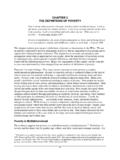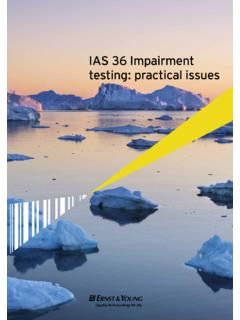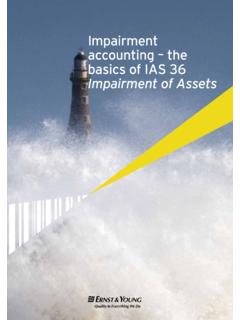Transcription of Practical Workshop for NBU Staff and Bankers …
1 Practical Workshop for NBU Staff and Bankers impairment IFRS 9 Practical issues and calculations Shamim Diouman Consultant, CFRR, the World Bank STAREP is supported with funding provided in part by European Union, Austria's Federal Ministry of Finance, Austrian Development Cooperation, Luxembourg's Ministry of Finance, SECO - State Secretariat for Economic Affairs May 2016. Introduction IFRS 9 single model requires lots of reliable information, for example: Information for estimating debtor's credit risk and identifying its significant increase. Information for estimating occurrence of default events within 12 months from the reporting date. Information for estimating occurrence of default events within the life of the instrument, their probable outcomes and weights;. Implications: Even slight change in 1 parameter can affect the resulting amount of recognized impairment loss and thus financial results of an entity. Therefore, it's everything else but NOT easy to adopt these newest requirements.
2 2. Data issues Identifying sources of historical and current data, and building PD and LGD. models when data is scarce. Incorporating macroeconomic forecasts to estimate forward-looking expected credit losses. Designing an impairment calculation workflow, integrating existing bank systems to improve timeliness of impairment calculations and on-going monitoring. Interpreting the changes required to existing PD and LGD models, and ensuring consistency with stress testing, ICAAP, and pricing models. Defining staging or transfer criteria to determine when loan provisioning should move from one-year to lifetime. 3. Data issues Reconciling existing Basel, financial, and accounting reporting. Integrating granular and aggregated calculation results for consumption by external accounting systems. Providing a financial dashboard to review attribution analysis between different reporting periods. Modeling and estimating complex parameters such as early term-out, prepayment, call options, and future expectations for floating or forward rates used in the expected credit loss calculation.
3 Calculating the credit-adjusted effective interest rate (EIR), required for discounting future expected losses. 4. Example Bank A has a total amount of loans of $605,000 issued to its clients. All the loans are valued at amortised costs in the balance sheet of the bank. Client XXX of bank A has officially filed for bankruptcy because their main product is an outdated smartphone. The last column of the table contains percentages of 12 months expected credit loss (ECL) in the individual age groups of the loans. The ECL is provided by a credible rating agency that calculates Expected Losses for different categories of loans and exposures. The ECL percentage is based on future expected losses only. There are no triggering event yet on these loans. The age structure of the loans are provided in the table in the next slide. What is the loan loss provision according to IAS 39 and IFRS 9 model of impairments? 5. Example Past due days Amount in $ % of expected credit loss Within maturity 500 000 1-30 days 50 000 31-90 days 25 000 91-180 days 15 000 181-365 days 7 000 365+ days 5 000 Client XXX 3 000 Sum 605,000.
4 6. IAS 39 impairment calculation Based on the previous table and assumptions, IAS 39. impairment is ..? What if we change the scenario: Within the outstanding$500,000 of loans which are within maturity, there is a big manufacturing client of the bank with outstanding loan of $200,000 (maturity of 4 years remaining) and its one and only big warehouse of stock has burnt down and it can be reliably estimated that for the next 5 years the sales, revenue, profit of the company will be affected by 50%. How would you calculate loan loss provision under IAS 39? 7. IFRS 9 impairment calculation IFRS 9 impairment calculations are: Loan loss provision = (500, )+(50, )+ ..+3000=. We are also assuming that there are significant increase in credit risk that would imply a change from stage 1 to stage 2. 8. Impact of ECL on banks The principal impact on banks is the need to recognize ECL at all times for all financial instruments, and at individual- and grouped-asset levels. Banks will have to update the ECL amounts at each reporting date to reflect changes in the credit risk of financial instruments.
5 This will significantly increase the number and frequency of impairment calculations that must be performed and the amount of information that must be collected to do so. The amount of information surfacing will increase in a number of aspects of delivering the new impairment approach; for instance, higher granularity, forecast of future losses, new models and simulation requirements. The model to calculate ECL introduces the need to consider every financial instrument at an individual-asset level, which means a large amount of data needs to be collected and processed. While the need to collect data at the individual-asset level exists today in banks ( , capital calculations), the level of data granularity required for the IFRS 9. impairment process represents a new challenge for finance departments. It is also worth noting that the assessment of the impairment process will fall under the scope of statutory auditors, which is not the case with capital calculations. 9. Example Bank B has a reporting date of 31 December.
6 On 1 July 20Y1. Bank B advanced a 3-year interest-bearing loan of CU3,500,000 to Company C. Management estimates the following risks of defaults and losses that would result from default at 1 July Y1 and at 31 December Y1 and Y2. 10. Example Period end A Risk of B Risk of C Loss that (A+B)*C Lifetime default in default in would result expected credit losses next 12 months 13-36 from default $. months % $. %. As at 1 July Y1 4 6 2,000,000 200,000. As at 31 Dec Y1 5 10 1,000,000 150,000. As at 31 Dec Y2 1 2 500,000 15,000. 11. Example What credit loss provision should Bank B book at: (i) 1 July Y1. (ii) 31 December Y1. (iii) 31 December Y2. 12. Example At 1 July Y1: On initial recognition Bank B should recognise a credit loss provision equivalent to 12- month expected losses. Stage 1. 12-month expected loss = (4% * $2,000,000] = $80,000. At 31 December Y1: Bank B evaluates whether credit risk has increased significantly since the loan was initially recognised (on 1 July Y1). Credit risk relative to initial recognition?)
7 The total risk of default has increased from 10%. to 15% which is significant. Is absolute level of credit risk low'? Although low' is not quantified, a risk of default certainly appears to not be low. IFRS 9 refers to an example of low credit risk being an external rating of investment grade'. The lowest rating generally considered investment grade is BBB' meaning adequate capacity to meet financial commitments. 13. Example The credit loss provision should therefore be based on lifetime expected losses. Lifetime expected loss = ( +10%) *. $1,000,000 = $150,000. 14. Example At 31 December Y2: Bank B again evaluates whether credit risk has increased significantly since 1 July Y1. The evaluations are as follows Credit risk relative to initial recognition? The total risk of default has now decreased to and is therefore lower than the risk at initial recognition of 10%. The credit loss provision should therefore return to being based on 12-month expected losses. 12-month expected loss = ( * $500,000) = $5,000.
8 15. Stage 3 impairment An entity might wish to use a local regulator's definition of non-performing loans' for determining when it needs to transfer assets into and out of Stage 3 of IFRS 9's impairment model. Under the local regulator's rules, a loan cannot be transferred back to the portfolio of performing loans until at least 12 months have elapsed from the point it was categorised as non- performing. Can the regulator's de nition of non-performing loans be used as the basis for making transfers into and out of Stage 3 of IFRS 9's impairment model? The regulator's definition of non-performing loans may not be appropriate for IFRS 9. purposes. IFRS 9 would require the asset to be transferred out of stage 3 if the credit risk on the financial instrument improves so that the financial asset is no longer credit- impaired. There is nothing in IFRS 9 to prohibit the transfer out of stage 3 occurring sooner than 12 months after the transfer into stage 3. The regulatory definition of non- performing loans may be a useful starting point in arriving at a definition of default, but will probably need to be amended to comply with IFRS 9.
9 16. Measurement period Example measurement period Entity E makes a 12-month loan to Entity F. The contract states that the loan can be extended for a further 6 months at the sole option of Entity E (the lender). Entity E's management considers that it is probable that the loan will be extended. It is assumed that the loan meets IFRS 9's solely payments of principal and interest' condition to be measured at amortised cost. In this example, the expected losses would be measured based on the 12-month contractual term. The measurement would not take into account possible future losses arising from management's decision to extend the loan for the additional 6. month period, unless or until the extension option is actually exercised. This is because the extension is at the sole option of the lender, so 12 months is the maximum contractual period over which the lender is exposed to credit risk. If Entity F (the borrower) has the right to extend the loan however, the maximum contractual credit risk period would be 18 months.
10 17. Measurement period Practical insight credit card and similar facilities Some financial instruments include both a loan and an undrawn commitment component, with the effect that the entity's contractual ability to demand repayment and cancel the undrawn commitment does not limit the entity's exposure to credit losses to the contractual notice period. Examples are revolving credit facilities, such as credit cards and overdraft facilities, which can be contractually withdrawn by the lender with as little as one day's notice. In practice lenders continue to extend credit for a longer period in such situations. The consequence of this is that the lender may frequently withdraw the facility only after the credit risk of the borrower increases, which could be too late to prevent some or all of the expected credit losses. IFRS 9. contains speci c guidance for such arrangements stating that the entity shall measure expected credit losses over the period that the entity is exposed to credit risk and expected credit losses would not be mitigated by credit risk management actions, even though the period may extend beyond the maximum contractual period.











